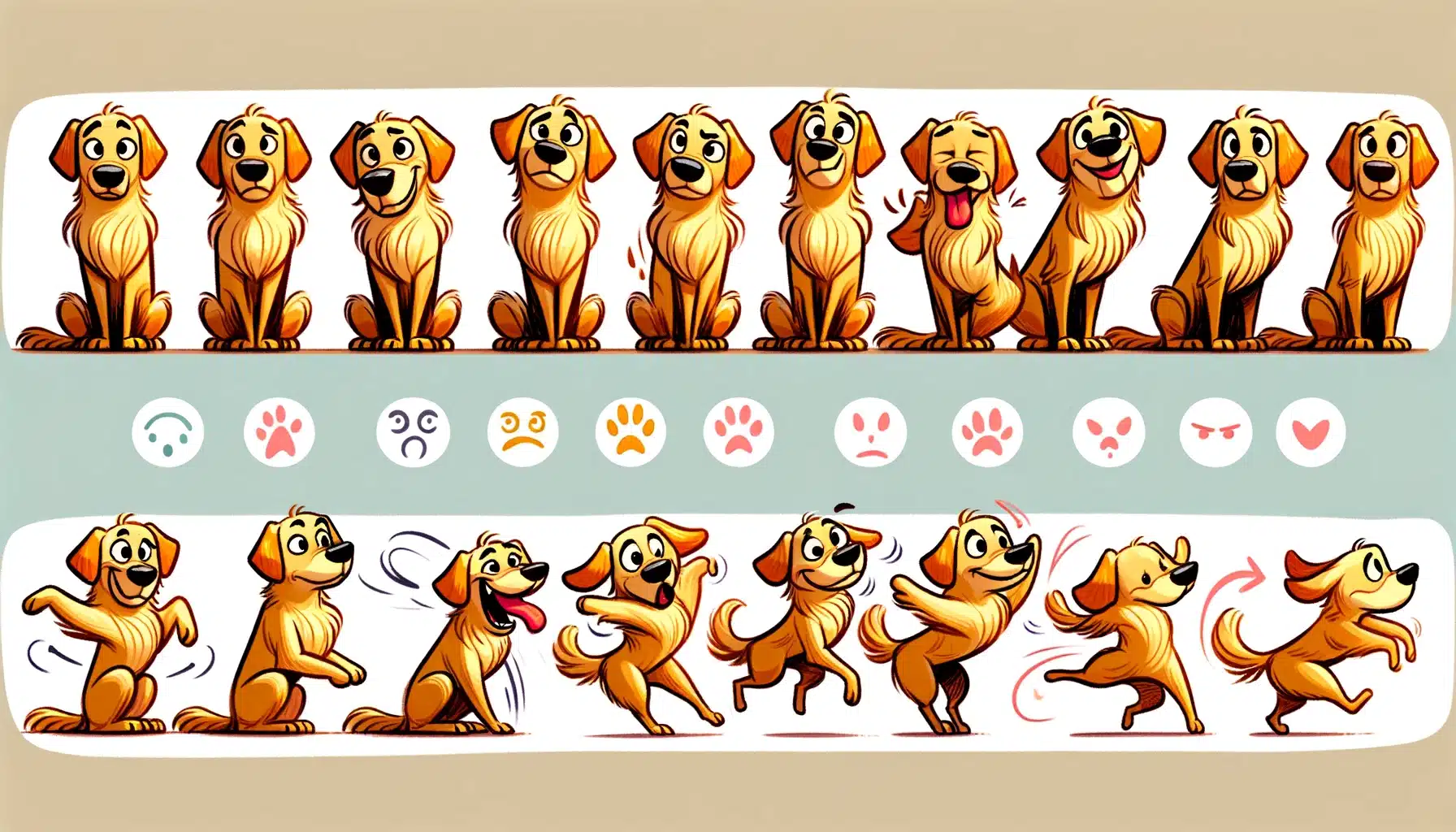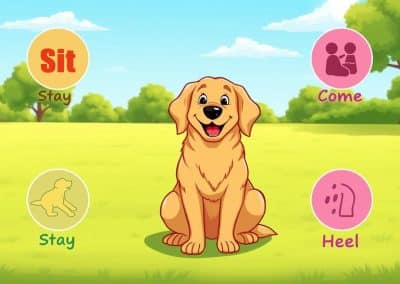Understanding your Golden Retriever’s body language is an integral part of pet parenting. Their actions can offer profound insights into their mood, comfort, and emotional state, acting as their way of communicating with their human counterparts. We’ve all witnessed tail wagging, paw licking, yawning, or peculiar posture adjustments – but do we truly grasp what our four-legged friend is trying to express? This write-up is all about demystifying those silent signals, enabling you to read your Golden Retriever’s visual cues, whether they signify joy, anxiety, curiosity, or stress. So, let’s dive right in and learn how to decode these nonverbal dialects effectively!
Identifying Key Golden Retriever Body Signals
Title: Unleashing Puppy Love: Decoding Your Golden Retriever’s Body Language
Golden Retrievers are an absolute bundle of joy, rightfully known for their friendly disposition, intelligence, and an undying loyalty to their pack — in this case, their beloved humans. They join us in our parenting journey, quickly becoming much more than pets, transforming into cherished family members. More often than not, they leave a paw print on everyone’s heart. However, these affectionate furbabies don’t speak “human”, so it’s significant to understand their body language to discern their emotions and needs. Let’s dive into the key body language signals you should look out for in your Golden Retriever.
-
- The Golden Tail Wag
There is hardly anything more endearing than a wagging tail! With a Golden Retriever, the key lies in the details. A leisurely wag says, “Hello! I’m happy to see you!”, while a rigid, quickly wagging tail indicates excitement, or sometimes, anxiety. If that tail is tucked between the legs, your fur friend may be feeling scared or uncomfortable.
-
- Ears That Listen
Your adorable Golden’s ears also speak volumes. An alert Golden Retriever will lift its ears or lean them forward. But if your canine companion’s ears flatten against their head, it’s time you took notice. This could be a sign of fear, submission, or anxiety.
-
- Eye-Contact-Seeking Golden
Golden Retrievers are known for their loving, expressive eyes that are watching and seeking interaction. When your Golden makes direct eye contact, it’s signaling trust and love. If they look away, it’s usually because they are feeling uncomfortable or wanting to avoid confrontation. Beware if your fur friend begins intensely staring at another dog or person. This is a sign of dominance or aggression.
-
- Happy Dog, Happy Home
Nothing beats a happy, relaxed Golden. Loose, fluid movements with a slight wriggle, eyes soft and calm, tongue lolling out in a happy pant, signal a content and joyful Golden. Conversely, stiff movements, tense facial features, or a non-wagging tail may indicate that your Golden Retriever is stressed or anxious.
-
- Playful Stance
A playful Golden is a sight to behold! Bouncy steps, a “play bow” (where the front end is lowered, and the tail-end stays in the air), or a happy dance around you denotes that it’s playtime. Alternatively, a rigid stance or tense body is a cautionary sign that they may be uncomfortable or threatened.
When it comes to connecting with your Golden Retriever, understanding their body language is paramount. It empowers you to cater to their needs and emotions better – strengthening the bond that you share. Remember, every dog is an individual, and these are general guidelines. Your fur companion may have unique ways of expressing itself. The more time you spend together, the more you’ll understand each other.
In the journey called family life, these warm, furry creatures make parenting all the more enjoyable and the house truly feel like home. So here’s to ‘pawsome’ companionships and a lifetime of tail wags, wet noses, and puppy love!

Positive vs. Negative Body Language in Golden Retrievers
Understanding Your Golden Retriever’s Body Language: Beyond the Basics
Every family member has a unique way of expressing themselves, and when our family includes a Golden Retriever, learning to comprehend their body language becomes a fascinating and insightful journey. If you’ve already begun to decode what different tail wags and ear positions mean, kudos to you! But there’s always more to learn about our loving, four-legged companions. Ready to take your understanding of your Golden Retriever’s body language to the next level? Let’s dive right in!
Key to interpreting any Golden Retriever’s behavior is acknowledging the importance of their body posture. A calm Golden Retriever will stand upright without tension in their body. The chest and neck will appear normal, not puffed out or pulled in. Keep an eye out for stiffness in the legs or body – this could indicate anxiety or discomfort. A move towards a crouching position could suggest anticipation or submission, depending on the context.
It’s likely no revelation that vocalizations are another critical piece of the puzzle. Barks, whines, growls, and howls each carry different meanings. Contented Golden Retrievers may emit soft, low-pitched barks or sighs whereas more urgent, high-pitched barks could signify excitement or demand for attention. Growling can signify a range of emotions from playful to fearful, depending on the situation, so be sure to consider the context!
All Golden Retriever parents should also familiarize themselves with the concept of submissive and dominant behaviors. When your Golden Retriever exhibits submissive behavior, they’re communicating respect, deference, or fear. This could be anything from tucking their tail and lowering their body to revealing their belly or avoiding direct eye contact. On the other hand, a raised tail, steady gaze, or lifted chest can all signify confident, assertive behavior.
Finally, don’t forget the importance of your Golden Retriever’s mouth and teeth! A relaxed and open mouth with a lolling tongue generally denotes a happy and comfortable companion. On the other hand, showing teeth – particularly with drawn back lips – can indicate fear, aggression, or discomfort.
To best decipher the language of your Golden Retriever, building a close, loving relationship is paramount. Spending time together will help you to identify their individual uniqueness and in turn, enhance your understanding of their distinct communications. And remember, every Golden Retriever is one-of-a-kind, so their expressions might differ slightly.
Bringing a Golden Retriever into the family is a joyous occasion. They shower us with unconditional love and are an endless source of fun and companionship! Being able to comprehend their body language is an enriching bonding experience that brings us one step closer to understanding our furry friends. Consider these tips the next time you interact with your Golden Retriever. By listening and observing carefully, we can create a happier, more harmonious household for us and our best four-legged friends.

Transitioning Signals in Golden Retrievers
Monitoring Your Golden Retriever’s Mood Changes: Decoding Body Language Signals
As wonderful as our world would be if our faithful Golden Retrievers could simply tell us what they need, we aren’t quite there yet. Instead, we must rely on keen observation of our furry friends to understand what their body language is communicating. This article will help you delve deeper into the subject and gain some insights into understanding your pet’s emotional state.
Identifying Volatile Body Posture Shifts
One of the most compelling cues about a Golden Retriever’s state of mind comes from its body posture. When a retriever is scared or feeling threatened, it may crouch down and make itself smaller. Alternatively, a confident and relaxed retriever will carry itself upright and tall, inviting interaction with an open stance.
Decoding Vocalizations
Golden Retrievers are talented communicators and use a range of vocalizations to express themselves. Understanding your own pup’s language is key to understanding their needs. A low growl can indicate discomfort while a sustained bark may show excitement or anxiety. Whimpers or whines may suggest pain, stress or simply that they want your attention.
Interpreting Behaviors: Submissive Vs. Dominant
Just like in human interactions, a Golden Retriever’s behavior can also indicate their mood and needs. Submissive behavior, like rolling onto the back or avoiding direct eye contact, is often a sign that a dog is feeling threatened or uncomfortable. Conversely, dominant behavior such as stiffening of the body, direct eye contact, or mounting can indicate assertiveness or excitement.
The Significance of the Mouth and Teeth
A Golden Retriever’s mouth and teeth can say a whole lot about their feelings. A relaxed Golden Retrievers often keep their mouth slightly open and their tongue lolling out. Conversely, if a dog is stressed or anxious, it might close its mouth tightly or bare teeth. A ‘smile’ or a gently opened mouth with teeth covered generally indicates a happy, content pup.
Uniquely Expressive Golden Retrievers
Each Golden Retriever has their own unique behaviors and expressions. Building a close relationship with your Golden will help you better understand their individual body language. Spend quality time together, engage in play, training, and simply sit with them in a calm, quiet space. You’ll start to notice the subtle nuances that make your dog uniquely theirs.
Golden Retrievers: Joy in the form of Furry Companionship
Throughout history, Golden Retrievers have been lauded for their friendly, eager-to-please demeanors. These lovable creatures bring an indescribable joy and companionship into a family’s life. Understanding your furry friend’s body language is the first step towards nurturing a relationship marked by mutual respect, love, and understanding.
In understanding the moods and needs of our Golden Retrievers, we all can create a deeper, more empathetic connection with our pets. Recognizing their body language cues is crucial in giving them a happy, healthy, and fulfilling family life they so richly deserve. After all, it’s one of the ways we can reciprocate the unconditional love they dispense so freely.

Interacting with a Golden Retriever based on their Body Language
Interacting with your Golden Retriever based on their body language is paramount in building strong communication and a bond. Keeping in mind that each dog is unique, it’s important to be aware of subtle variations in their behavior. Here’s what to focus on:
- Spotting Volatile Body Posture Shifts:
Remember that signs may be obvious or subtle. For instance, a rigid body or stiffly wagging tail is a normally a clear indication that the Golden Retriever is uncomfortable or upset. Meanwhile, a relaxed body with loose tail wagging often signifies contentment or excitement. Observing your pet’s body posture regularly helps ensure a healthier and happier relationship.
- Decoding Vocalizations:
Golden Retrievers communicate quite a lot through varied sounds and vocal patterns. Paying attention to the fine differences in their barks, whines or growls can aid in comprehending their needs. A playful bark differs from an aggressive one; a distressful whine, from an excited one. Recognizing these vocal cues forms the backbone of a thriving communication.
- Interpreting Behaviors: Submissive vs. Dominant:
A dominant Golden Retriever often displays a stiff posture, direct eye contact, and a raised tail. A submissive dog on the other hand, might lower their body, avoid eye contact and tuck their tail between their legs. Understanding if your pet is feeling dominant or submissive can assist in providing the right kind of response or intervention.
- Understanding the Significance of the Mouth and Teeth:
A relaxed, open mouth is often a sign of a content dog. Conversely, stress or fear can cause a Golden Retriever to close their mouth tightly, or show their teeth. Tongue flicking and lip licking can signify anxiety. Recognizing these signs can aid in quickly alleviating any rising tensions.
- Uniquely Expressive Golden Retrievers:
Golden Retrievers are renowned for their expressive nature. This means they often have their own unique way of communicating that is specific to their personality. It could be a specific tilt of the head, a unique tail wag, or even a consistent whimper. A deep and meaningful relationship can be built by understanding your Retriever’s unique expressive tendencies.
- Respecting the Moods and Needs of the Golden Retriever:
Just like humans, Retrievers have moods and needs too. At times they may want to play, other times they may want to be left alone to rest. Respecting their space, especially when they are ill or asleep, can contribute to their overall mental wellbeing. Always ensure to fulfill their basic needs of food, exercise, and regular check-ups.
Golden Retrievers: Joy in the Form of Furry Companionship:
Golden Retrievers are known for their pleasant and friendly demeanor, making them incredible companions. Adequately understanding their body language not only strengthens your bond but also adds to their charisma that brings unlimited love and joy within families.
In conclusion, learning to “speak” Golden Retriever through body language observations and interpretations can deepen the bond you share with your furry friend. It’s an enriching experience that can turn every day into a delightful adventure in parenting your Golden Retriever.

Keenly observing your Golden Retriever’s body language and responding appropriately based on their emotional state fosters a deeper connection, builds mutual trust, and ensures their overall wellbeing. As you grow attuned to your pet’s unique communication style, you’ll become adept at preempting unexpected behavioral shifts and providing them with the comfort or stimulation they need in a given situation. Remember, your Golden Retriever depends on you to understand and meet their needs. So enhance your sense of awareness, be responsive, and above all, enjoy the enriching journey of a blossoming bond with your incredible furry friend.









